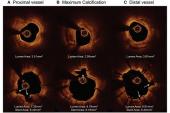Disrupt CAD III Shows Sustained Benefit for Lithotripsy at 1 Year
(UPDATED) Comparisons with other technologies are needed and costs are high, but ease of use makes it a “no-brainer,” says Morton Kern.

(UPDATED) In stable CAD patients, using intravascular lithotripsy to break up superficial or deep calcium and pave the way for stent implantation results in good outcomes to 1 year, with low rates of MACE, cardiac death, and all-cause mortality, according to results from the Disrupt CAD III trial.
Lithotripsy with high-energy shock waves has been used for decades to treat kidney stones, but it has only recently been applied to coronary artery calcium. Last year at TCT 2020, 30-day results from the single-arm Disrupt CAD III trial showed that intravascular lithotripsy exceeded performance goals for both the primary safety endpoint of freedom from 30-day MACE (cardiac death, all MI, or TVR), as well as the primary effectiveness endpoint of procedural success. MACE occurred in 7.8% of patients and TLF in 7.6%, driven primarily by periprocedural MI.
Largely on the basis of the Disrupt CAD trial series, the US Food and Drug Administration approved the intravascular lithotripsy system (Shockwave Medical), which uses a balloon to deliver sonic pressure waves that can pass through arterial tissue to “disrupt” and fracture calcified plaque, improving the ability to achieve optimal stent expansion. Potentially, it could displace atherectomy devices as standard-of-care for calcific lesions, although costs are already emerging as a barrier.
Presenting the 1-year data in a featured clinical research presentation at TCT 2021, Matthew Price, MD (Scripps Translational Science Institute, La Jolla, CA), showed a MACE rate of 13.8% and TLF rate of 11.9%, again driven by periprocedural MI (9.2%) with no Q-wave MIs beyond 30 days.
“This confirms the ongoing safety and efficacy of the technology,” Price told TCTMD. “The 1-year event rates appear acceptable, given the complex lesions that were studied.”
Morton J. Kern, MD (VA Long Beach Healthcare System and University of California, Irvine), who was a panelist during the session, said the long-term data are a good step forward for the technology, adding that he doesn’t see many downsides for operators, given how easy the balloon is to use. “It really is a no-brainer in terms of learning curve,” he observed.
That being said, Kern, speaking with TCTMD, highlighted the fact that that the trial had no comparison arm and noted that the cost of the device, at about $4,700 per balloon, is five times the price of a DES and about 50 times the price of a conventional balloon. It is roughly double the cost of atherectomy devices on the market today.
“There also wasn't much detail about how many times they needed to predilate to get [the balloon] across,” he added. “But, it’s easy, it’s familiar, and I think operators like it. Going forward, likely there'll be some head-to-head comparison with rotablators.”
A Complementary Therapy
DISRUPT CAD III enrolled 431 patients at 47 sites in four countries. The number available for follow-up at 1 year was 373. All had stable, unstable, or silent ischemia. The average calcified segment length was 48 mm, with all graded as severely calcified by the core lab, and side-branch involvement in 30%.
At 1 year, cardiac death had occurred in 1.1% of patients, MI in 10.5%, TVR in 6%, ischemia-driven TLR in 4.3%, and definite or probable stent thrombosis in 1.1%. One patient had a definite or probable stent thrombosis beyond 30 days, which translated to a late stent thrombosis rate of 0.3%. The Kaplan-Meier estimate for mortality at 1 year was 1.8%.
In analysis of MACE rate by subgroup, there were no differences except by lesion length. Among lesions < 25 mm, the rate of 1-year MACE was 9% versus 18% for lesions ≥ 25 mm (P = 0.02). Although the longer lesion group also had numerically double the rate of TVR compared with the shorter lesion group, the difference was not statistically significant.
According to Price, the higher MACE is likely a function of long lesions rather than the technology, as result of doing more work on those vessels and putting in more stents. “The fact that you see higher MACE rates in those lesions does not necessarily mean we shouldn't be treating longer lesions,” he added.
In multivariate analysis, independent predictors of MACE at 1 year were bifurcation lesions, prior MI, and being a current or former smoker. The only predictor of TVR was prior MI.
In terms of where it fits in clinical practice, Price said he sees intravascular lithotripsy as a “complementary technology,” noting that the next step is to figure out when to use it appropriately.
“There are clearly subtotal occlusions which you can't get a balloon across, and you're going to have to use some sort of atherectomy technology,” he said. “On the other hand, there are lesions where you can get a balloon across. We saw very infrequent significant or serious complications with intravascular lithotripsy, which I think is a really important aspect of the technology. As we move forward as a field, we need to really specify in which groups each technology may be most appropriate.”
For Kern, other questions that remain include optimal inflation pressures and number of pulses needed, because there is a limited number that can be used per catheter. The extreme cost also comes into play with regard to balloon length, since needing more than one could be a “budget breaker.” However, Kern said among the important potential advantages of intravascular lithotripsy over atherectomy is a lower risk of perforation. In the 30-day outcome reporting last year, the Disrupt CAD III investigators said no perforations occurred postprocedure, with a single documented perforation during the postdilatation of the stent.
Price concluded that the 2-year follow-up from the trial will provide needed insight into whether intravascular lithotripsy can reduce longer term annualized events.
Commenting on the study for TCTMD, Prashant Kaul, MD (Piedmont Heart Institute, Atlanta, GA), said while intravascular lithotripsy is a pretreatment strategy that leaves nothing behind per se, it is important to confirm that lithotripsy has no long-term vascular sequalae.
“So, the 1-year results of the study, showing continued safety and efficacy in what intuitively feels like a safe technology, are important,” he said in an email.
Kaul agreed that intravascular lithotripsy should be viewed as a complementary technology, noting that it is essential for operators, especially those that may not be experienced with atherectomy, to respect calcium, and not treat intravascular lithotripsy as an atherectomy replacement device.
“As we see increased adoption of adjunctive intracoronary imaging and improvement in both recognizing and assessing calcification, operators will develop a better understanding of where [intravascular lithotripsy] fits into the algorithm for the treatment of calcified lesions, especially as it relates to nodular and more eccentric calcification, which may still require the use of traditional ablative therapies,” Kaul added.
L.A. McKeown is a Senior Medical Journalist for TCTMD, the Section Editor of CV Team Forum, and Senior Medical…
Read Full BioSources
Price M. Intravascular lithotripsy for treatment of severely calcified coronary lesions: 1-year results from the Disrupt CAD III study. Presented at: TCT 2021. Orlando, FL. November 5, 2021.
Disclosures
- Price reports consultant fee/honoraria/speaker's bureau (personal) from Abbott Vascular, Boston Scientific, Medtronic, W.L. Gore, Baylis Medical, Acutus, BioSense Webster, and Shockwave; and equity/stock(s)/options (personal) in Indian Wells and Intershunt.





Comments